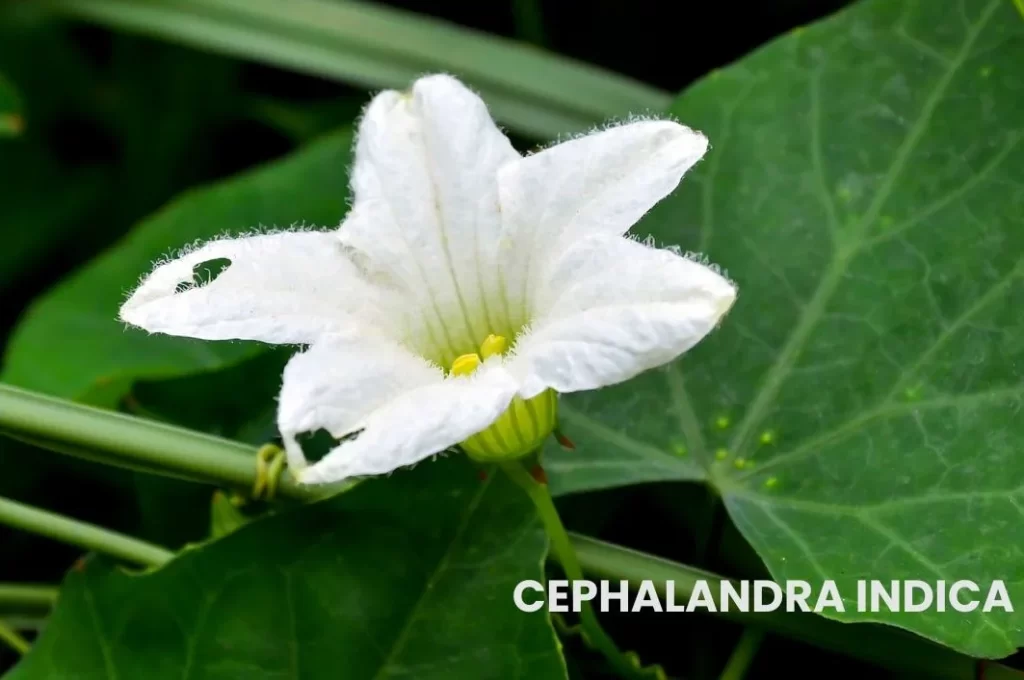Cephalandra Indica, commonly known as Telakucha, is a medicinal plant belonging to the Cucurbitaceae family.
It has a long history of use in traditional medicine systems for various health conditions, including diabetes mellitus, skin issues, jaundice, and dropsy.
First Prover: S.C. Ghosh.

SOURCE INFORMATION
Scientific Classification
- Kingdom: Plantae
- Clade: Angiosperms
- Clade: Eudicots
- Order: Cucurbitales
- Family: Cucurbitaceae
- Genus: Cephalandra
- Species: Cephalandra Indica
Origin and Distribution
- Cephalandra Indica is native to regions of Asia, particularly India, where it has been used in traditional medicine for centuries.
- It is also found in other tropical and subtropical regions around the world.
Historical Facts
- Throughout history, Cephalandra Indica has been valued for its medicinal properties, especially in the treatment of diabetes mellitus.
- Traditional healers in India have long used various parts of the plant to manage diabetes symptoms and other health issues.
- Its historical use in Ayurveda and other indigenous medical systems underscores its significance in traditional medicine practices.
Homoeopathic Preparation
- In homeopathy, Cephalandra Indica is prepared as a mother tincture or in potentized forms for therapeutic use.
- The plant’s leaves or other parts are collected and processed to extract its medicinal properties using maceration and percolation techniques.
- The resulting liquid extract, known as the mother tincture, undergoes serial dilution and succussion to prepare different potencies of the remedy.
DRUG PATHOGENESIS
- Cephalandra Indica primarily affects the urinary system and gastrointestinal tract, with symptoms such as profuse urination, weakness after urination, and dryness of mouth and throat.
- It is indicated for conditions like diabetes mellitus, characterized by sugar in the urine and weakness and exhaustion after urination.
KEY CHARACTERISTICS
- Burning sensations are prominent in various parts of the body, including the eyes, face, mouth, and throat.
- Symptoms include giddiness, weakness, loss of appetite, flatulency, greenish mucous stool with blood, and intermittent pulse.
PSYCHOLOGICAL PROFILE
- Morose and Fretful: Individuals may exhibit a gloomy disposition, feeling irritable or easily annoyed.
- Disinclined to Work: There is a reluctance or lack of motivation to engage in activities or tasks.
- Gloomy: A sense of sadness or pessimism may prevail in the individual’s mindset.
- Partial Loss of Memory: There may be difficulty in recalling certain information or events, indicating a partial loss of memory function.
- Oversensitivity: Both mentally and physically, individuals may be overly sensitive to external stimuli, reacting strongly to minor triggers.
DETAILED ORGAN SYMPTOMS
- Head: Giddiness worsens after urination, accompanied by weakness.
- Eyes: Burning sensation in the eyes.
- Face: Burning sensation on the face.
- Mouth: Dryness of the mouth with intense thirst for large quantities of water.
- Throat: Dryness and discomfort in the throat.
- Appetite: Loss of appetite.
- Abdomen: Flatulency.
- Urine: Profuse urination, weakness, and exhaustion afterward, with the presence of sugar in the urine, indicative of diabetes mellitus.
- Stool: Greenish mucous stool with blood, accompanied by pain before and during defecation.
MODALITIES
- Symptoms worsen after urination.
WHAT ARE MODALITIES IN HOMOEOPATHY?
DOSE
- The potency of choice for Cephalandra Indica is the mother tincture, 1x, or 3x.
- The dosage and frequency of administration should be determined by a qualified homeopathic practitioner based on individual symptoms and constitution.
Frequently Asked Questions (FAQs)
What is the meaning of “diabetes mellitus”?
- Diabetes mellitus is a metabolic disorder characterized by high blood sugar levels over a prolonged period, resulting from inadequate insulin production or insulin resistance.
Can Cephalandra Indica be used for diabetes management?
- Yes, Cephalandra Indica is indicated for diabetes mellitus, particularly when symptoms such as profuse urination and weakness after urination are present.
Is Cephalandra Indica safe for self-medication?
- It is always recommended to consult a qualified homeopathic practitioner for proper diagnosis and treatment, as self-medication may not yield optimal results and could lead to complications.
What is “intermittent pulse”?
- An intermittent pulse refers to an irregular or interrupted heartbeat, where there are pauses or variations in the rhythm of the pulse.
Meaning of difficult words
- Telakucha: Another name for Cephalandra Indica.
- Cucurbitaceae: A family of flowering plants commonly known as the gourd family, which includes cucumbers, pumpkins, and watermelons.
- Maceration: The process of soaking plant material in a solvent to extract its medicinal properties.
- Percolation: A method of extracting medicinal compounds from plants by passing a solvent through a permeable substance.
- Serial dilution: The process of repeatedly diluting a substance with a solvent to create increasingly potent solutions.
- Succussion: Vigorous shaking or tapping of a solution during the process of potentization in homeopathic remedy preparation.
- Morose: Having a gloomy or sullen disposition.
- Fretful: Anxious or irritable, often accompanied by restless behavior.
- Disinclined: Unwilling or lacking desire to do something.
- Giddiness: A feeling of dizziness or light-headedness.
- Flatulency: Excessive gas or bloating in the digestive system.
- Diabetes mellitus: A metabolic disorder characterized by high blood sugar levels due to inadequate insulin production or insulin resistance.
- Intermittent pulse: An irregular or interrupted heartbeat, where there are pauses or variations in the rhythm of the pulse.
